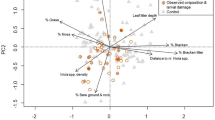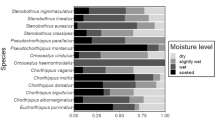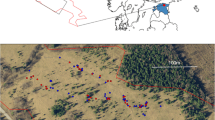Summary
Females of the damselfly Calopteryx maculata (de Beauvois) initially choose the larger of a pair of adjacent oviposition sites, about 70% of the time (Table 1), or whichever of two equal sized sites had other ovipositing females on it (about 88% of the time-Table 2). These criteria for initial choice between a pair of sites also interact. Incoming females generally (57 to 74% of the time-Table 3) joined others on the small site rather than ovipositing alone at the adjacent, bigger site. When pairs of large and small sites were replicated across eight locations, there were nonsignificant trends towards greater utilization (eggs laid) of the larger of a pair of oviposition sites within locations (Table 4). The lack of agreement between initial choice and utilization shows that other factors besides size are important in the choice and use of oviposition sites. These include disturbance by males, the presence of other females and choice criteria that can only be assessed during oviposition. When all sites at the eight locations were equal in size, there was considerable day to day and location to location variation in eggs laid (Fig. 1). Viewed over periods of several days, some sites are obviously less attractive than others in terms of cumulative numbers of eggs laid at them. When the amount of vegetation was varied among locations, those with the bigger oviposition sites were used more often, somtimes significantly so, but there were also significant reversals (small sites used more often) (Table 5, Fig. 1). Thus, there is no simple effect of size on the utilization of oviposition sites by Calopteryx maculata females, despite a clear tendency for females to make initial choices based on this criterion. The considerable among and within location variation in number of eggs laid may reflect additional choice criteria or the interaction of size, the presence of other females, disturbance, and location.
Similar content being viewed by others
References
Alcock J (1979) Multiple mating in Calopteryx maculata (Odonata: Calopterygidae) and the advantage of non-contact guarding by males. J Nat Hist 13:439–446
Alcock J (1983) Mate guarding and the acquisition of new mates in Calopteryx maculata (p. de Beauvois) (Zygoptera: Calopterygidae). Odonatologica 12:153–159
Banks MJ, Thompson DJ (1985) Lifetime mating success in the damselfly Coenagrion puella. Anim Behav 33:1175–1183
Corbet PS (1980) Biology of Odonata. Ann Rev Entomol 25:189–227
Fincke OM (1982) Lifetime mating success in a natural population of the damselfly Enallagma hageni (Walsh) (Odonata: Coenagrionidae). Behav Ecol Sociobiol 10:293–302
Fincke OM (1984) Giant damselflies in a tropical forest: reproductive biology of Megaloprepus coerulatus with notes on Mecistogaster (Zygoptera: Pseudostigmatidae). Adv Odonatologica 2:13–27
Fincke OM (1986) Lifetime reproductive success and the opportunity for selection in a non-territorial damselfly (Odonata: Coenagrionidae). Evolution 40:791–803
Hafernik Jr JE, Garrison RW (1986) Mating success and survivorship in a population of damselflies: Results at variance with theory? Am Nat 128:353–365
Koenig WD, Albano SS (1987) Patterns of territoriality and mating success in the white-tailed skimmer Plathemis lydia (Odonata: Anisoptera). Am Midl Nat 114:1–12
Koenig WD, Albano SS (1987) Lifetime reproductive success, selection, and the opportunity for selection in the white-tailed skimmer, Plathemis lydia (Odonata: Anisoptera). Evolution 41:22–36
Sherman KJ (1983) The adaptive significance of postcopulatory mate guarding in a dragonfly, Pachidiplax longipennis. Anim Behav 31:1107–1115
Waage JK (1972) Longevity and mobility of adult Calopteryx maculata. Odonatologica 1:155–162
Waage JK (1974) Reproductive behavior and its relation to territoriality in Calopteryx maculata (Beauvois) (Odonata; Calopterygidae). Behaviour 47:240–256
Waage JK (1978) Oviposition duration and egg deposition rates in Calopteryx maculata (Beauvois)(Zygoptera; Calopterygidae). Odonatologica 7:77–88
Waage JK (1979a) Dual function of the damselfly penis: sperm removal and transfer. Science 203:916–918
Waage JK (1979b) Adaptive significance of postcopulatory guarding of mates and non-mates by male Calopteryx maculata (Odonata). Behav Ecol Sociobiol 6:147–154
Waage JK (1983) Sexual selection: ess theory and insect behavior: some examples from damselflies (Odonata). Fla Entomol 66:19–31
Waage JK (1984) Sperm competition and the evolution of odonate mating systems. In: Smith RL (ed) Sperm competition and the evolution of animal mating systems. Academic Press, New York, pp 251–290
Author information
Authors and Affiliations
Rights and permissions
About this article
Cite this article
Waage, J.K. Choice and utilization of oviposition sites by female Calopteryx maculata (Odonata: Calopterygidae). Behav Ecol Sociobiol 20, 439–446 (1987). https://doi.org/10.1007/BF00302987
Received:
Accepted:
Issue Date:
DOI: https://doi.org/10.1007/BF00302987




